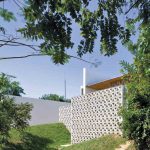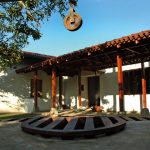-
Tsunami Interpretive Centre, Hambantota
October 2013

STUDENT: Buddhini Shashika Wijesinghe | INSTITUTION: City School of Architecture
“A wave came from the East,
We could not ride it,
We could not swim across,
Could not dive under…
We could do nothing about it…
We just didn’t know Tsunami”
TRAUMA TRANSITION TRANSCENDENCE
A survivor’s journey of remembrance
On December 26, 2004, the Indian Ocean Tsunami, generated by a massive earthquake off the Island of Banda Aceh, measuring 9.1–9.3 on the moment magnitude scale, struck the densely populated and highly vulnerable coastal underbelly of Asia with devastating force. By the time the waters subsided, the catastrophe had claimed the lives of nearly three hundred thousand people and scientists had to take cognisance of one of the deadliest natural disasters in recorded history and the third largest earthquake ever recorded on a seismograph. Almost 2,000 miles away from the quake’s epicenter, in Sri Lanka and the Subcontinent, tsunamis were unheard of. Thousands of lives could have been saved, however, if an international warning system such as the one established in the Pacific Ocean had been set in place in the Indian Ocean rim region.
The Tsunami Interpretive Centre for Hambantota was envisioned as a response to this single worst tsunami in history, in a locale where 15,000 people lost their lives—a figure constituting nearly half of the reported casualties for Sri Lanka. Located on a bluff overlooking the fisheries harbour, it comprises a Court of Remembrance or memorial to those who lost their lives in the disaster, a Tsunami Awareness Centre in the form of an interactive museum, a Tsunami Monitoring Centre and an Evacuation Point. The site itself is a ten-acre peninsular with a promontory rising nearly 70 feet above the Indian Ocean, which creates a convenient cove for the fisheries harbour lying to its north. It was chosen on account of its high ground and position of vantage, allowing for the speedy evacuation of the town’s bazaar and central business district in the event of a similar disaster.
The design draws its inspiration from the hilly site’s complex genius loci, comprising its micro settings in the form of valley, cavern, cliff and summit. In essence, it concretises an exploratory pathway across these settings in the form of a gradual ascent from the valley at the base of the hill through the cavern and past the cliff to its summit, tracing a possible escape route to high ground and safety. This pathway, in turn, transforms itself into a promenade that is a spatial mimesis of this escape as it meanders across the site to become the Court of Remembrance, Hall of Raging Waters, Hall of Midnight Rainbows, Court of Hope, Compassion and Dignity, Gallery of Transcendence, Court of Acceptance and Summit of Safe Haven, which are the exhibition spaces of the Tsunami Awareness Centre. Thus, the entire centre, which is a metaphor for the survivor’s escape from the raging wall of water that inundated the base of the promontory to safety at the summit of the site, may also be conceived as his cathartic journey of remembrance upon revisiting the site of trauma.
With a spring in his step and hope in his heart, then, the visitor-survivor enters the Gallery of Transcendence where creative works of other survivors are on display
The Tsunami Interpretive Centre is accessed along a ramp that lies parallel to the road skirting the fisheries harbour. Upon reaching the entrance one is overwhelmed by a peaceful vista—that of the Indian Ocean lapping at the base of the promontory. Almost immediately, however, the eye is drawn to the foreground where an obsidian-black reflecting pool stretches before the visitor and merges with the waters of the ocean in the distance, reminding us of nature’s fickle ferocity. The grim ambience here reminds one that this is a place of death and mourning. One has, in effect, entered the Court of Remembrance comprising the Pavilion of Solitude, Wall of Sorrow on which is engraved the names of those who lost their lives and the Memorial Bridge with its 15 beacons of light, representing the 15,000 who died in the tsunami.
The visitor, silenced by the magnitude of the disaster, is overcome by an inexplicable urge to escape into more cheerful surroundings and locates a ramp that ushers him away from this oppressive space. However, he is granted no respite. And, as he enters the Hall of Raging Waters, he is confronted by the awesome destructive power of the tsunami via the larger than life images and video displays.
…the visitor-survivor walks out on to the sweeping public concourse of the open to sky Court of Acceptance located close to the summit of the Promontory…
Bowed down by the devastation wrought by the catastrophe, the visitor enters the Hall of Midnight Rainbows and encounters the first glimmer of hope, which continues to grow as he progresses through the other exhibition spaces of the Interpretive Centre. This space represents the humane mission to provide relief to the survivors and the steps taken by the concerned government to ensure that another disaster of this nature does not take place. Here, the nature of the light that is admitted into the space strikes a note of hope for the first time since the visitor’s entry into the centre. Passing on from this exhibition space the visitor transitions the Court of Hope, Compassion and Dignity representing the magnanimity of the human spirit that came to the aid of the survivors during the disaster. This is a sand covered area of tranquillity and repose with a symbolic tree of life growing at its centre. Here, stories of courage and compassion abound, uplifting the spirits of the visitors. With a spring in his step and hope in his heart, then, the visitor-survivor enters the Gallery of Transcendence where creative works of other survivors are on display. This space represents the indomitable courage and fortitude of the human spirit as it grapples with tragedy and loss, through cathartic outpourings of creativity. It is testimony to the fact that mere survival is not sufficient for life to go on: the spirit must also thrive.
With the trauma of the catastrophe behind him, the visitor-survivor walks out on to the sweeping public concourse of the open to sky Court of Acceptance located close to the summit of the promontory—to confront the ocean for a second time, at peace with himself and the world and without fear this time around. From thence, retracing his steps, he enters the Gallery of Transcendence once more, and ascends a final flight of stairs to the Summit of Safe Haven and completes the journey to safety and equanimity. Appropriately, this area combines the functions of belvedere, evacuation point, open air theatre, public restaurant, Tsunami Monitoring Centre and landscaped parkland for recreation purposes.





















